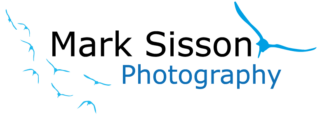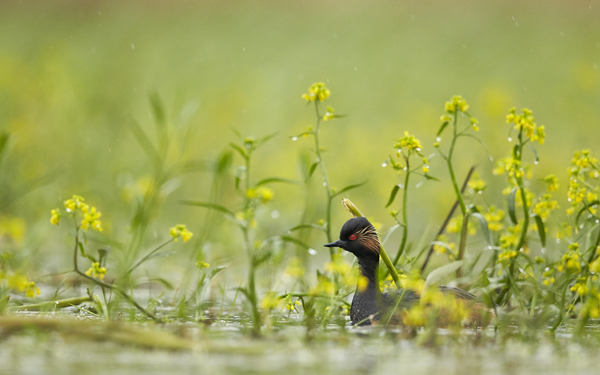One of the advantages of having been born under an Aquarian star sign is that I love water. I have always been happy in it, on it or beside it whether it be fresh or saline in its nature. Given that it is home to an array of wildlife that you just don’t see in any other environment I’m glad I am as comfortable being in it as I am especially as it opens up the possibilities of some very different images and experiences.
Those of you who know my work of old may recall a trip I made to Bulgaria a couple of years ago and wrote about here. Given my almost lifetime obsession with the Grebe family the time spent with them, in particular the Black-necked Grebe which has to be one of the most striking birds of all the wetlands in Europe, was one that I was really looking forward to taking a small group of guests to experience once again in the same region of northern Bulgaria around the shores of the mighty Danube river.
As you can see the Black-necked Grebes once again excelled and this was the very first shot of the trip, taken on a drizzly first evening after the first flight of the day from Luton airport while everyone was getting used to how the challenges of working from a floating hide could best be managed.
The water levels at the area I had spent my time previously were even higher this Spring and as a result were too deep for many of the birds – they can’t dive that far to search for food – and so although we tried a session there which involved flippers and a lot of swimming, we were mostly working in a new wetland area not far away. The amount of foliage was much greater which made manoeuvring that bit harder and getting a clear shot also that bit harder too but on the occasions when these striking birds did then it was always a treat.
Over time the foliage, and in particular a long channel (the deepest area of this particular wetland where I could only just touch the bottom) which was full of bright yellow flowers at times provided a very picturesque setting in which to photograph the birds, whether they be Grebes or Ducks.
Of course there were plenty of other settings and species to work with as well and the beauty of working in a floating hide like this is that given time to slowly and carefully (and therefore unobtrusively) re-position yourself most viewpoints, foliage allowing, could be achieved. The pockets of reed beds provided a great setting for Pygmy Cormorants to rest and dry their wings or the constantly singing (and very loudly too) Great Reed Warblers to proclaim their territories.
Because the water levels were that much lower than I had worked in here in the past and also because of the increased level of foliage, there were greater numbers of long-legged water based birds to be found too. They would be standing stationary around the fringes or on bits of foliage waiting to pounce on one of the many Marsh Frogs or Fire-bellied Toads that there were in the water. They were very wary and so approaching them in the hide was a slow and careful process but there were some very close encounters with Night Heron, Grey Heron and even Little Bittern: it’s a very different experience being at water level with these birds.
I’d never had a clean view of one of these smaller relatives of the European Bittern we occasionally see here in the UK and when this individual moved into a great position on a willow tree (surrounded by water and reeds) it took me almost an hour to work carefully into position for a clear view. When the sun then came out fleetingly and lit him up perfectly in the shadows it was well worth it though.
Around the fringes of the wetland areas were an array of passerines – while getting changed into our wetsuits every session we would be serenaded by Cuckoo, Nightingale and watched over by a Red-backed Shrike – the bird diversity here is as good as it has been the dozen or so years I have travelled and photographed in Bulgaria I’m pleased to say. One bird that was well into its breeding was the extraordinary Penduline Tit and his fantastic construction of a nest had been taken up by a female and he was busily providing food for her almost constantly and so we spent a very enjoyable afternoon trying to capture images of him as he returned.
But I was always drawn back to the Grebes in particular. The one European species I have always ironically found the hardest to photograph well is the Little Grebe or dabchick as I fondly still call it. They are very shy and retiring and although I have plenty of images from iconic and less-visited locations at home they have never really done them justice. Of all the species here it was them I wanted to really try to work with this time if I could.
They could be heard all around the area – if I had to count I would have guessed at least a dozen pairs, some in close proximity to one another too. But they remained as elusive as they always seem to be. They are small and adept enough to dive and swim underwater to feed in the tightest of reed beds quite happily so have little need to come into the open patches of water except to move speedily to another sheltered area. As a result opportunities with them for the first couple of days proved frustrating and environmental in their nature.
 Mind you when the environment consists of the aforementioned yellow flowers though then it does produce settings that really sing and with amazing texture to the images as well.
Mind you when the environment consists of the aforementioned yellow flowers though then it does produce settings that really sing and with amazing texture to the images as well.
 On occasions though patience and perseverance is rewarded, and although it was an encounter that totalled less than a minute when one bird popped up from his dive almost in front of me in beautiful morning light and a setting that was nigh on perfect too then the hours of wading, avoiding the leeches and having to clean the wetsuit of mud twice a day was more than made up for.
On occasions though patience and perseverance is rewarded, and although it was an encounter that totalled less than a minute when one bird popped up from his dive almost in front of me in beautiful morning light and a setting that was nigh on perfect too then the hours of wading, avoiding the leeches and having to clean the wetsuit of mud twice a day was more than made up for.
Stunning birds (and probably my favourite family of them) a stunning location and great company (thanks Martin, Jeff and Peter for joining me and my good friend Emil for helping pull it all together as always). This aquarian will be back in the water again soon for sure.




















Truly stunning photos with wonderful explanatory text. Thanks so much for sharing your Bulgarian birding experience.
Thanks Risa – I have been travelling and photographing there for a dozen or so years now and it always offers up special encounters!